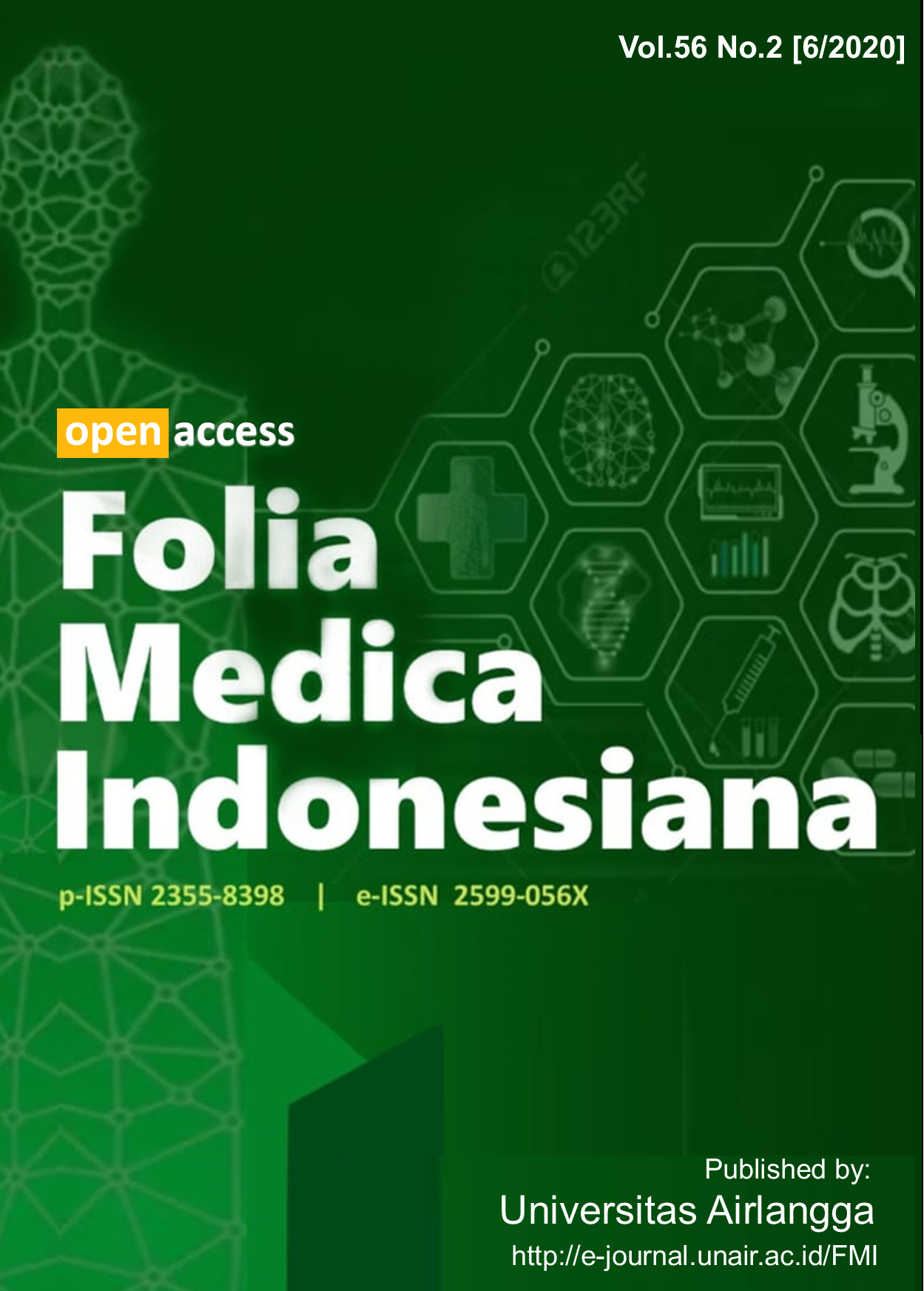Main Article Content
Abstract
Keywords
Article Details
Copyright (c) 2020 Folia Medica Indonesiana

This work is licensed under a Creative Commons Attribution-NonCommercial-ShareAlike 4.0 International License.
-
Folia Medica Indonesiana is a scientific peer-reviewed article which freely available to be accessed, downloaded, and used for research purposes. Folia Medica Indonesiana (p-ISSN: 2541-1012; e-ISSN: 2528-2018) is licensed under a Creative Commons Attribution 4.0 International License. Manuscripts submitted to Folia Medica Indonesiana are published under the terms of the Creative Commons License. The terms of the license are:
Attribution ” You must give appropriate credit, provide a link to the license, and indicate if changes were made. You may do so in any reasonable manner, but not in any way that suggests the licensor endorses you or your use.
NonCommercial ” You may not use the material for commercial purposes.
ShareAlike ” If you remix, transform, or build upon the material, you must distribute your contributions under the same license as the original.
No additional restrictions ” You may not apply legal terms or technological measures that legally restrict others from doing anything the license permits.
You are free to :
Share ” copy and redistribute the material in any medium or format.
Adapt ” remix, transform, and build upon the material.

References
- Aminsharifi A, Irani D, Amirzargar H (2018). Shock wave lithotripsy is more effective for residual fragments after percutaneous nephrolithotomy than for primary stones of the same size: a matched pair cohort study. Current Urology 12, 27-32
- Desai M, De Lisa A, Turna B, Rioja J, Walfridsson H, Addessi A, Wong C (2011). The clinical research office of the endourological society percutaneous nephrolithotomy global study: Staghorn versus nonstaghorn stones. International Braz J Urol, 37, 661
- Hamamoto S, Yasui T, Okada A, Taguchi K, Kawai N, Ando, R, et al (2014). Endoscopic combined intrarenal surgery for large calculi: simultaneous use of flexible ureteroscopy and mini-percutaneous nephrolithotomy overcomes the disadvantageous of percutaneous nephrolithotomy nonotherapy. Journal of Endourology 28, 28-33
- Lee HY, Yang YH, Lee YL, Shen JT, Jang MY, Shih PMC, et al (2015). Noncontrast computed tomography factors that predict the renal stone outcome after shock wave lithotripsy. Clinical Imaging 39, 845-850
- Olvera-Posada D, Ali SN, Dion M, Alenezi H, Denstedt JD, Razvi H (2016). Natural history of residual fragments after percutaneous nephrolithotomy: evaluation of factors in related to clinical events and intervention. Urology 97, 46-50
- Opondo D, Gravas S, Joyce A, Pearle M, Matsuda T, Sun YH, et al (2014). Standardization of patient outcomes reporting in percutaneous nephrolithotomy. Journal of Endourology 28, 767-774
- Pearle M, Lingeman J, Leveillee R, Kuo R, et al (2008). Prospective randomized trial comparing shock wave lithotripsy and ureteroscopy for lower pole caliceal calculi 1 cm or less. Journal of Urology 179, S69-S73
- Rosette J de la, Assimos D, Desai M, Gutierrez J, Lingeman J, et al (2011). The clinical research office of the endourological society percutaneous nephrolithotomy global study: indications, complications, and outcomes in 5803 Patients. Journal of Endourology 25, 11-17
- Xu G, Li X, He Y, He Z (2012). Staged single-tract minimally invasive percutaneous nephrolithotomy and flexible ureteroscopy in the treatment of staghorn stone in patients with solitary kidney. Urological Research 40, 745-749
- Zhang L, Peng F, Yang L, Zhao X, Yang J, Zhang X (2009). Effect of extracorporeal shock-wave lithotripsy on residual stones after different methods of surgery (abstract). Zhong Nan Da Xue Xue Bao Yi Xue Ban 34, 634-637
References
Aminsharifi A, Irani D, Amirzargar H (2018). Shock wave lithotripsy is more effective for residual fragments after percutaneous nephrolithotomy than for primary stones of the same size: a matched pair cohort study. Current Urology 12, 27-32
Desai M, De Lisa A, Turna B, Rioja J, Walfridsson H, Addessi A, Wong C (2011). The clinical research office of the endourological society percutaneous nephrolithotomy global study: Staghorn versus nonstaghorn stones. International Braz J Urol, 37, 661
Hamamoto S, Yasui T, Okada A, Taguchi K, Kawai N, Ando, R, et al (2014). Endoscopic combined intrarenal surgery for large calculi: simultaneous use of flexible ureteroscopy and mini-percutaneous nephrolithotomy overcomes the disadvantageous of percutaneous nephrolithotomy nonotherapy. Journal of Endourology 28, 28-33
Lee HY, Yang YH, Lee YL, Shen JT, Jang MY, Shih PMC, et al (2015). Noncontrast computed tomography factors that predict the renal stone outcome after shock wave lithotripsy. Clinical Imaging 39, 845-850
Olvera-Posada D, Ali SN, Dion M, Alenezi H, Denstedt JD, Razvi H (2016). Natural history of residual fragments after percutaneous nephrolithotomy: evaluation of factors in related to clinical events and intervention. Urology 97, 46-50
Opondo D, Gravas S, Joyce A, Pearle M, Matsuda T, Sun YH, et al (2014). Standardization of patient outcomes reporting in percutaneous nephrolithotomy. Journal of Endourology 28, 767-774
Pearle M, Lingeman J, Leveillee R, Kuo R, et al (2008). Prospective randomized trial comparing shock wave lithotripsy and ureteroscopy for lower pole caliceal calculi 1 cm or less. Journal of Urology 179, S69-S73
Rosette J de la, Assimos D, Desai M, Gutierrez J, Lingeman J, et al (2011). The clinical research office of the endourological society percutaneous nephrolithotomy global study: indications, complications, and outcomes in 5803 Patients. Journal of Endourology 25, 11-17
Xu G, Li X, He Y, He Z (2012). Staged single-tract minimally invasive percutaneous nephrolithotomy and flexible ureteroscopy in the treatment of staghorn stone in patients with solitary kidney. Urological Research 40, 745-749
Zhang L, Peng F, Yang L, Zhao X, Yang J, Zhang X (2009). Effect of extracorporeal shock-wave lithotripsy on residual stones after different methods of surgery (abstract). Zhong Nan Da Xue Xue Bao Yi Xue Ban 34, 634-637

